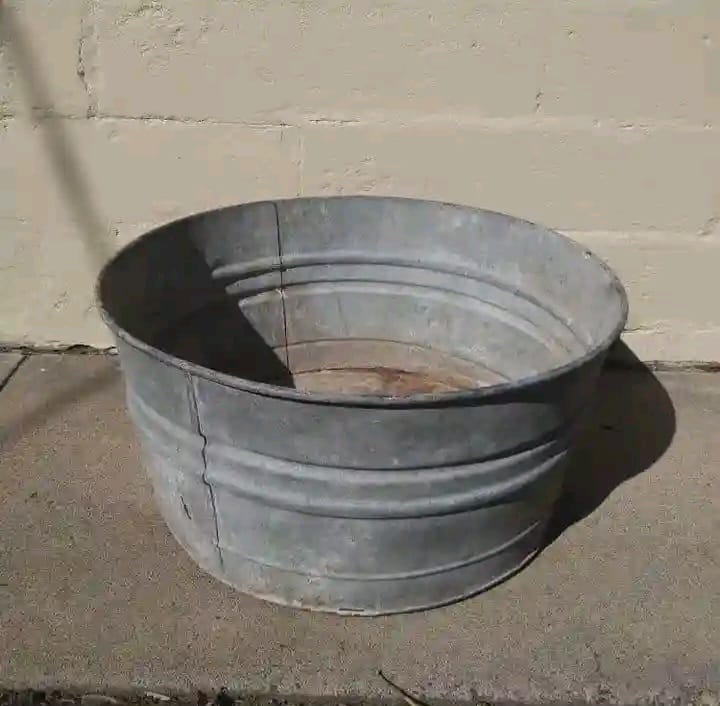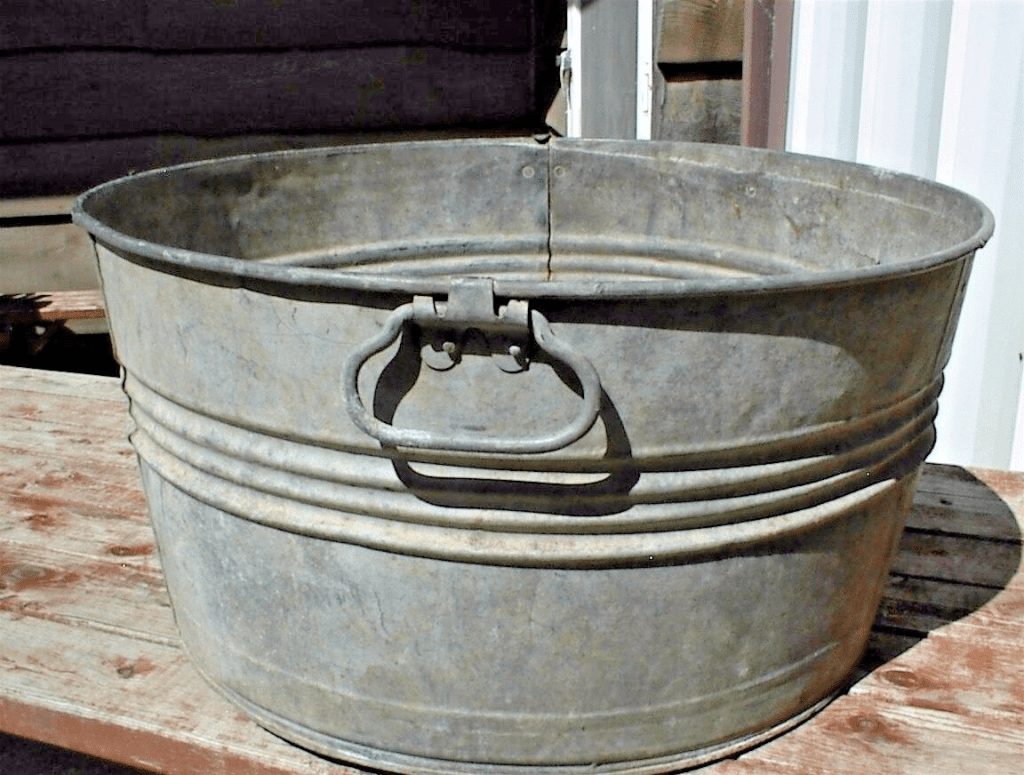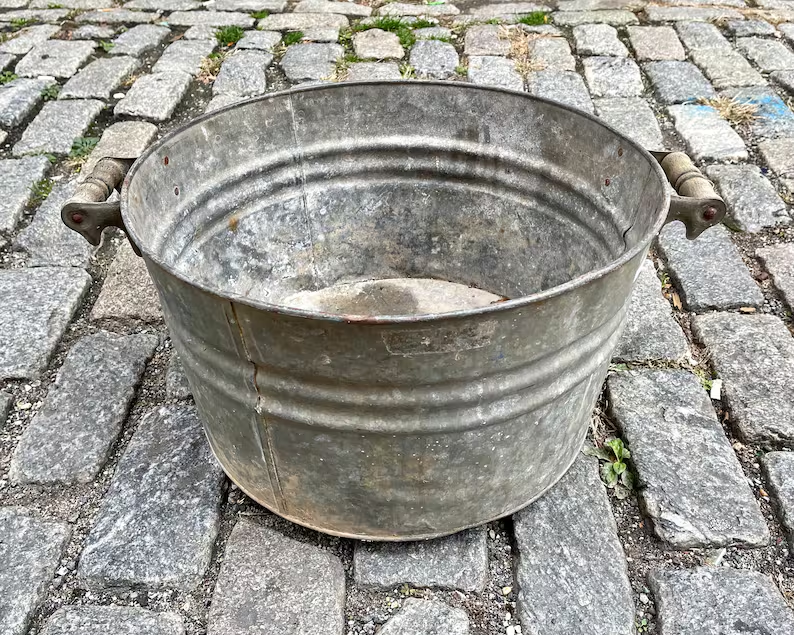Galvanized wash tubs hold a unique place in history, representing resilience, practicality, and the enduring human spirit. These durable metal tubs were more than mere household items—they were symbols of survival and resourcefulness, especially for families displaced by World War II. Today, they stand as reminders of the past and provide a fascinating lens into the lives of those who relied on them for daily chores and much more.
The Origin of Galvanized Wash Tubs

Galvanized wash tubs gained popularity in the late 19th and early 20th centuries, prized for their durability and versatility. Made by coating steel or iron with zinc to prevent rust, these tubs were built to last, even in challenging conditions. They quickly became household staples for washing laundry, bathing children, and storing water or other essentials. Their simple, rugged design ensured they could withstand years of use, even in harsh environments.
The Role of Wash Tubs in the Lives of Migrants
After World War II, millions of displaced people migrated to new countries in search of better lives. Among their few belongings, galvanized wash tubs often made the journey with them. For families like the Pierzaks, who migrated from Poland to Australia in 1950, these tubs were essential tools for survival.
- In Migrant Camps
Migrants lived in temporary camps, often with limited resources. The wash tub served multiple purposes—it was used to wash clothes, bathe children, and even adults. In many ways, it became a symbol of normalcy amid upheaval. - In Early Settlements
Once these families settled into bungalows or makeshift homes, the wash tub remained central to daily life. Before indoor plumbing became commonplace, tubs like these were vital for washing and bathing. They connected displaced families to their routines and traditions, offering a sense of stability.
The Pierzak Family’s Story: A Testament to Resilience
The story of the Pierzak family encapsulates the historical significance of galvanized wash tubs. Stanislaw and Teodozja Pierzak, originally from Poland, endured unimaginable hardships during World War II, working as forced laborers in Germany. After the war, they were among the many displaced families who found refuge in camps managed by the United States Army.
In 1950, they chose to migrate to Australia, bringing their wash tub along as one of their few belongings. This tub became an essential tool for their family’s daily survival in migrant camps across New South Wales and later in their first homes in North Sunshine, Victoria. It wasn’t just a utilitarian object; it was a link to their past and a tool that helped them build their future.
Practical Uses of Galvanized Wash Tubs
These tubs were much more than laundry tools. Their versatility made them indispensable in various contexts, especially in communities with limited access to modern amenities. Here are some common uses:

- Washing Clothes
Before the widespread availability of washing machines, galvanized tubs were the go-to solution for laundry. Paired with a washboard, they made cleaning clothes more efficient. - Bathing
For families without running water or bathrooms, the tubs doubled as portable bathtubs. Parents often bathed their children in these tubs, ensuring cleanliness despite challenging circumstances. - Food Storage and Preparation
In rural or resource-limited areas, the tubs were used to store grains, soak fruits, or even hold water for livestock. Their sturdy build and large capacity made them ideal for such tasks. - Emergency Water Reservoirs
During periods of drought or water shortages, galvanized tubs served as essential water storage containers. Their rust-resistant construction ensured water remained safe for extended periods.
The Evolution of Wash Tubs in Australia
In post-war Australia, galvanized wash tubs became synonymous with the migrant experience. Families arriving from Europe brought these tubs as part of their luggage, relying on them during their early years in the country. The Pierzaks, for instance, used their tub extensively in camps and later in their first home—a converted garage in North Sunshine.
As communities developed and homes were built with proper bathrooms and laundries, the tubs transitioned from essential household items to relics of a bygone era. Today, they are valued for their historical significance and as collectibles.
Symbolism and Legacy of Galvanized Wash Tubs
These tubs symbolize the resourcefulness and adaptability of displaced families. For many, they represent the struggles and triumphs of building a new life in unfamiliar lands. They remind us of a time when simplicity and utility were paramount, and every object had to serve multiple purposes.

In a broader sense, galvanized wash tubs are artifacts of human resilience. They tell stories of migration, adaptation, and survival, offering a tangible connection to the past. Their enduring legacy continues to inspire, reminding us of the importance of preserving history.
Repurposing Galvanized Wash Tubs Today
Though their original purpose has largely been replaced by modern appliances, galvanized wash tubs have found new life in creative ways:
- Garden Planters
Their sturdy construction and rustic aesthetic make them perfect for growing flowers, herbs, or small vegetable gardens. - Outdoor Decor
Many people use these tubs as decorative items, filling them with fairy lights, seasonal ornaments, or even using them as beverage coolers during gatherings. - DIY Projects
With a bit of creativity, galvanized tubs can be transformed into furniture pieces like stools or tables, blending functionality with vintage charm.
Conclusion
The humble galvanized wash tub is far more than a household item—it’s a symbol of resilience, resourcefulness, and history. For families like the Pierzaks, it was a lifeline during times of immense challenge, providing utility and a connection to the routines that sustained them. Today, these tubs stand as a testament to the ingenuity of displaced people and their determination to adapt and thrive. Whether as historical artifacts or repurposed treasures, galvanized wash tubs continue to remind us of the enduring human spirit.


